Art History
The Surprising Backstory Behind Gustav Klimt’s Obsession With Gold
How the artist's father and a fateful trip to Italy fueled his fascination with the glittery hue.
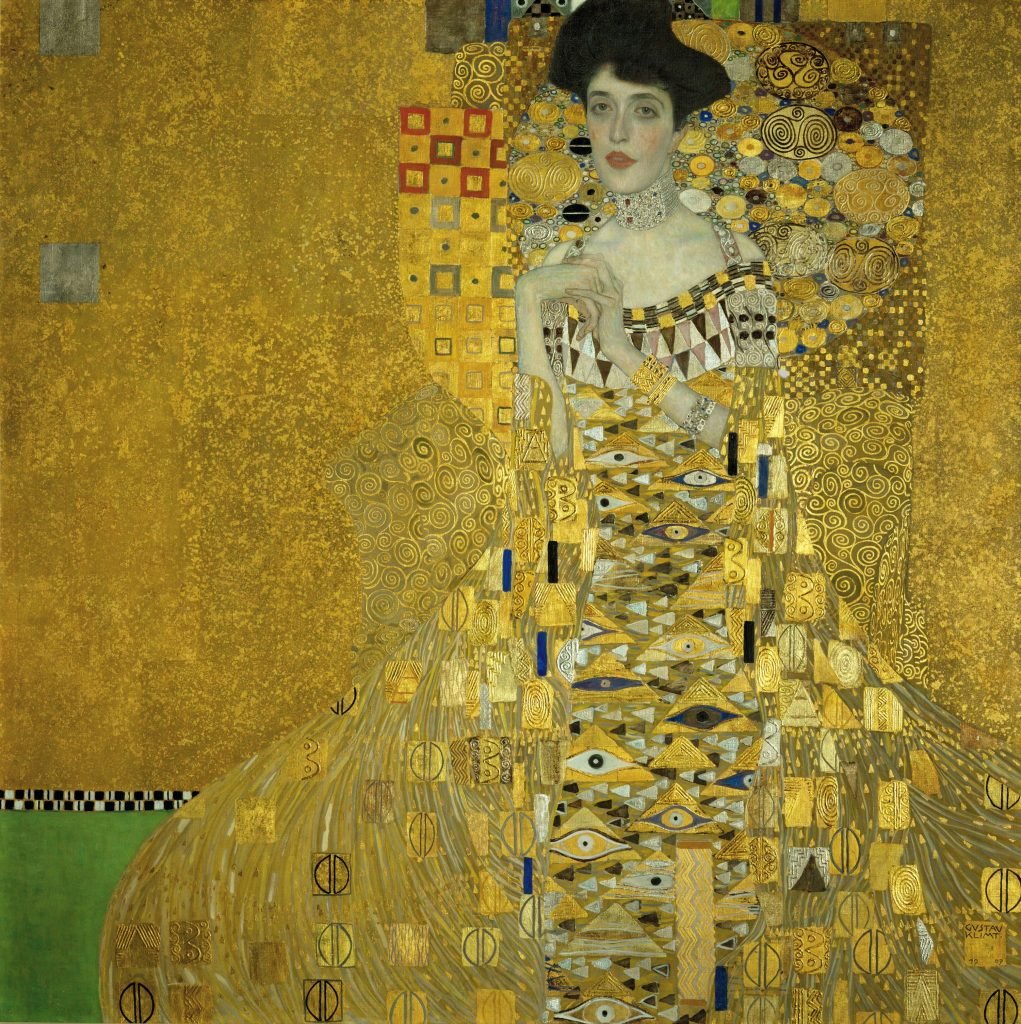
Gustav Klimt made gold modern.
At the turn of the 20th century, the Viennese artist captivated public attention with his sinuous depictions of women (and occasionally men) which he adorned with copious amounts of gold leaf. These visions—which were sensual and often erotic, featuring glittering backgrounds—changed the course of 20th-century art.
Most famous among these was his masterpiece, The Kiss (1907–08) (called The Lovers by the artist), which depicts a man and woman embracing, their bodies dissolved into golden abstractions, in a moment of transcendence. It has become the icon of the artist’s celebrated “Golden Phase,” an era of work when ornamental gold leaf featured prominently across his canvases. Pallas Athene, from 1898, is considered the earliest work from this period, which the artist continued until 1909. In this painting, the Greek goddess Athena appears in golden armor with an imperious stare. With gold leaf applied to the background and her armor, the painting hints at the disembodied and majestic beauty of Klimt’s later works, while still hewing to his earlier realist style. Right now, this style-shifting painting is on view “Secessions: Klimt, Stuck, Liebermann on view at Wien Museums in Vienna, Austria, through October 13, 2024.
An Aesthetic Rebellion, Leafed With Gold
To the surprise of many, these golden-laced works comprise only a small fraction of the artist’s oeuvre. A founding artist of the Vienna Secession, an art movement closely aligned to Art Nouveau in France, Klimt rebelled against the stagnancy of traditional styles and embraced cross-disciplinary influences. Throughout his relatively brief lifetime (he died at 55 from the effects of the Spanish flu), he was prolific, and drew daily; more than 4,000 of his drawings survive today. He painted over 200 paintings, it is believed, of which over 160 are known.
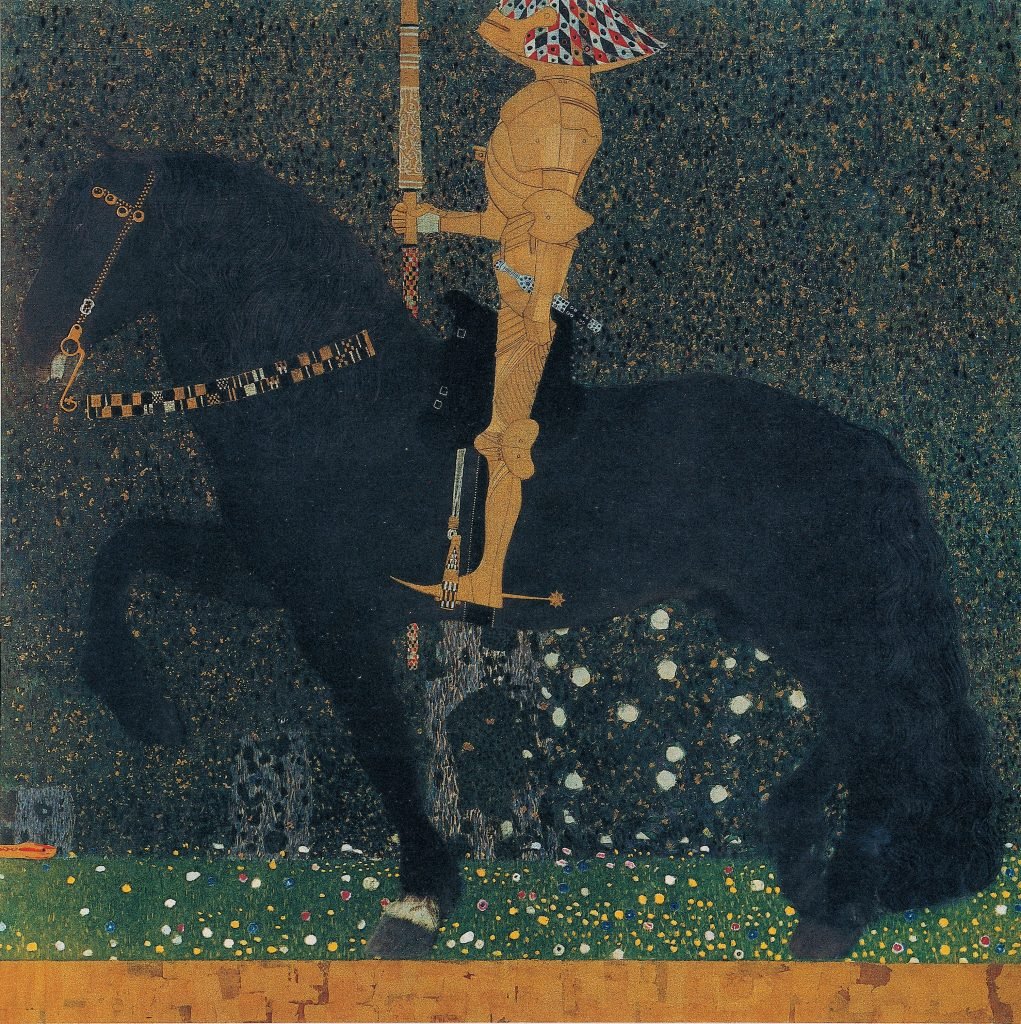
Gustav Klimt, Life is a Struggle (The Golden Knight ) (1903). Photo by Imagno/Getty Images.
Depictions of armor became one way Klimt introduced gold into his canvases. In 1902 and again in 1903, he painted a knight in golden armor, first in his famous “Beethoven Frieze,” which was presented to the public in 1902 for the 14th Secession exhibition, followed by his painting Life is a Struggle (The Golden Knight) in 1903 which pictures a knight astride a dark horse. But in these same years, Klimt used gold liberally and creatively, adorning his backgrounds and ornamenting his figures with gold leaf and coloring, creating intricate decorative patterns.
But what was behind Klimt’s decade-long love affair with gold, exactly? It turns out, his inspirations were more varied and purposeful than one might have expected.
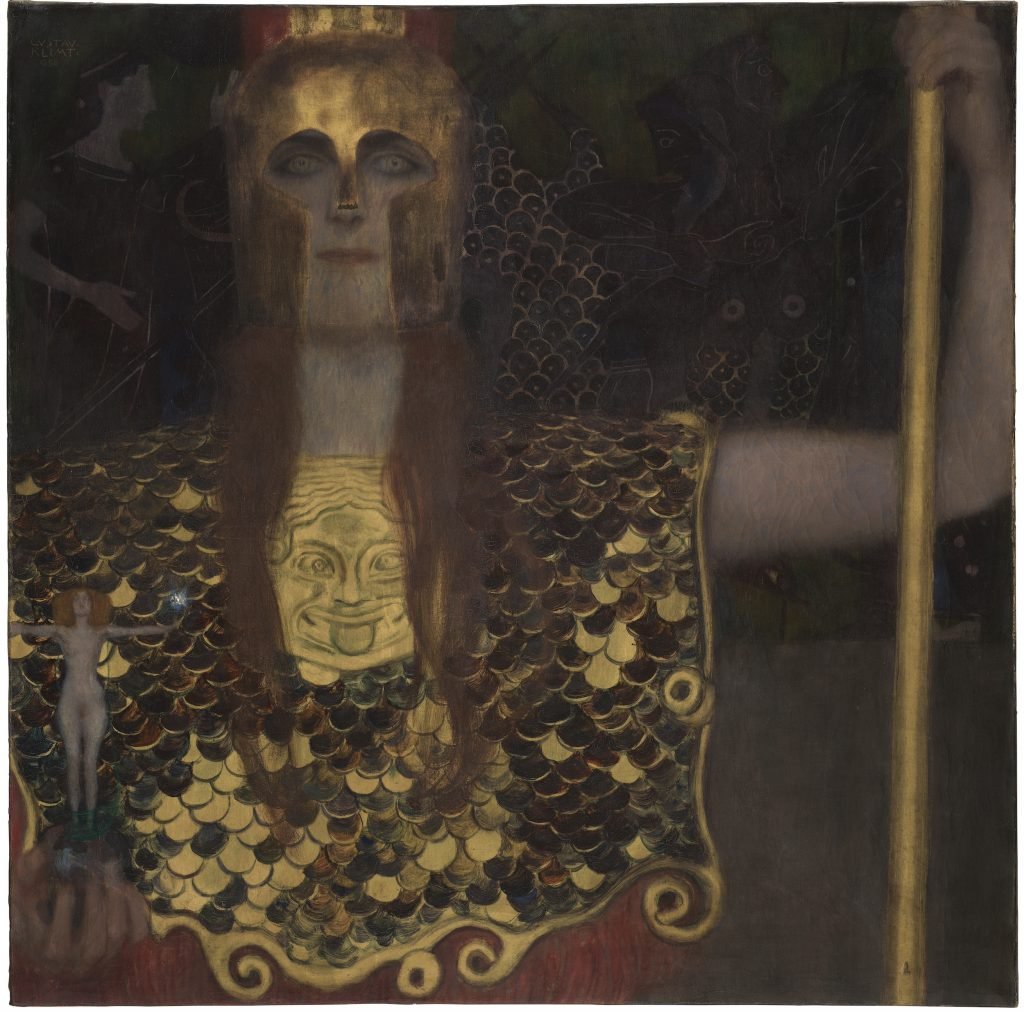
Gustav Klimt, Pallas Athene (1898). Courtesy of Wien Museu. Photo: Birgit und Peter Kainz.
Goldsmithing Was the Klimt Family Business
Gustav Klimt was born in 1862, the second of five children in a creatively oriented family. His mother, Anna Klimt (née Finster), had unfulfilled dreams of a life as a musical performer. His father, Ernst Klimt, was a goldsmith and an engraver. Certainly, Klimt’s dexterity with gold and his appreciation for the so-called decorative arts were fueled by his familial household. Much like Botticelli, who started his career in goldsmithing and continued to adorn his canvases with gold, Klimt embraced the material for its beauty and symbolism.
Gustav wasn’t the only child in the Klimt family with artistic inclinations, either. His younger brother, also named Ernst, became an established history painter and decorative painter. Gustav, whose earlier works were in a more realist tradition, formed a company with his younger brother and a friend to take on commissions.
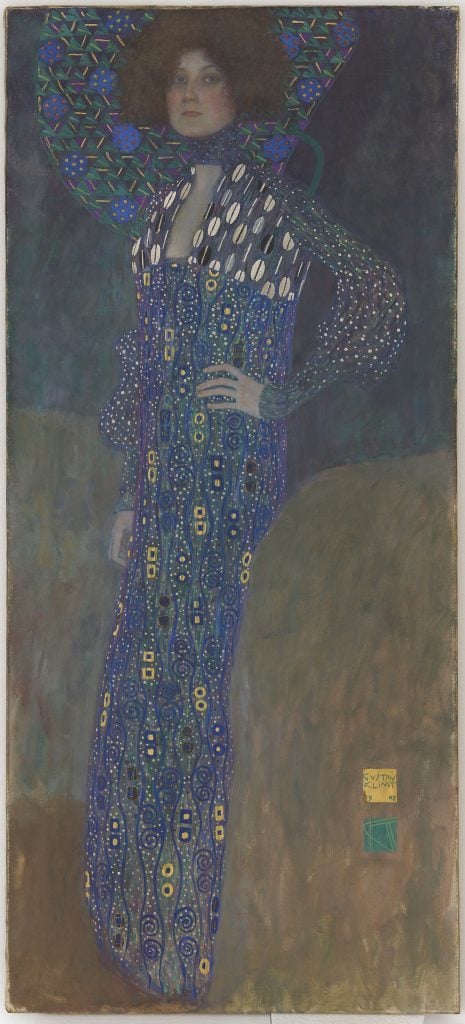
Gustav Klimt, Portrait of Emilie Flöge (1902). Courtesy of Wien Museu. Photo: Birgit und Peter Kainz.
Later in life, Gustav would work with his youngest brother Georg, an engraver and metal worker, too. Georg most prominently created the doors to the famed Vienna Secession building in 1897. At times the elder Klimt commissioned frames from his younger brother, as is the case of the golden frame surrounding Pallas Athena (1898). These collaborations underscored Klimt’s enthusiasm for decorative arts, his passion for gold, and the enduring familial ties that shaped his works.
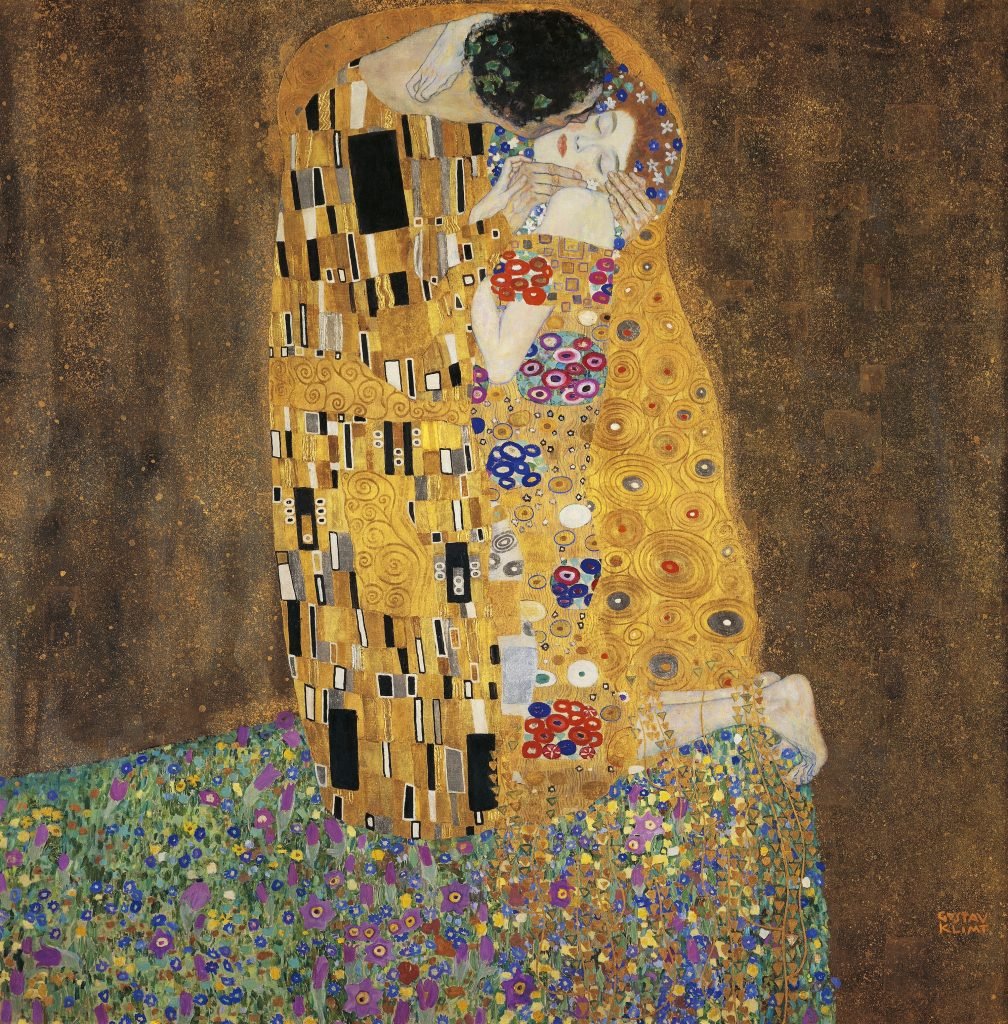
Gustav Klimt, The Kiss (1907). Photo by DeAgostini/Getty Images); Vienna, Österreichischer Galerie Belvedere (Art Gallery). Photo by DeAgostini/Getty Images.
The Sacred and the Profane
Klimt had an omnivorous artistic appreciation, embracing the flatness of Japanese prints, the motifs of Egyptian mythology, and Impressionists’s modernism.
When it came to his passion for gold, religious iconography of the Byzantine era came to the fore. In 1903, Klimt took pivotal trips to Venice and (twice) to Ravenna, Italy. The artist wrote to his romantic partner Emilie Flöge that he considered Ravenna’s glittering mosaics “incredibly stunning,” including the famed depictions of Emperor and Empress Justinian and Theodora. Art historians have found compositional parallels between Klimt’s regal portrait of Viennese socialite Adele Bloch-Bauer and the centuries-old rendering of the Byzantine Empress Theodora.

Empress Theodora and her retinue, Byzantine mosaic in the apse of the Basilica of San Vitale (UNESCO World Heritage Site, 1996), Ravenna, Emilia-Romagna, Italy, 6th century.
In Byzantine mosaics and icons, gold signaled an eternal realm, existing beyond time and saturated by divine light. The flattened, discarnate figures in these artworks symbolized the out-of-body experience of religious transcendence. Klimt uses gold to create a similar sense of timeless infinity; the backgrounds of his Golden Period are dotted with glittering flecks of gold, but also silver and platinum, creating an almost cosmic-looking backdrop for his scenes.
But while Klimt’s use of gold signaled a sense of ecstasy, it was that of earthly, than heavenly pleasures. “All art is erotic,” Klimt once wrote, and his work, as a whole, undeniably delights in the raptures of the female figure (Klimt was a notoriously amorous man, and had at least 14 children in his lifetime through hushed affairs).
At the dawn of the 20th century, he—albeit controversially—sought to elevate representations of carnal pleasures to the status of the spiritual. His 1901 Judith, for instance, depicts the ancient Jewish heroine, not in the violent physicality of her altercation with Holofernes, but in a pose of unbridled sensual conquest.
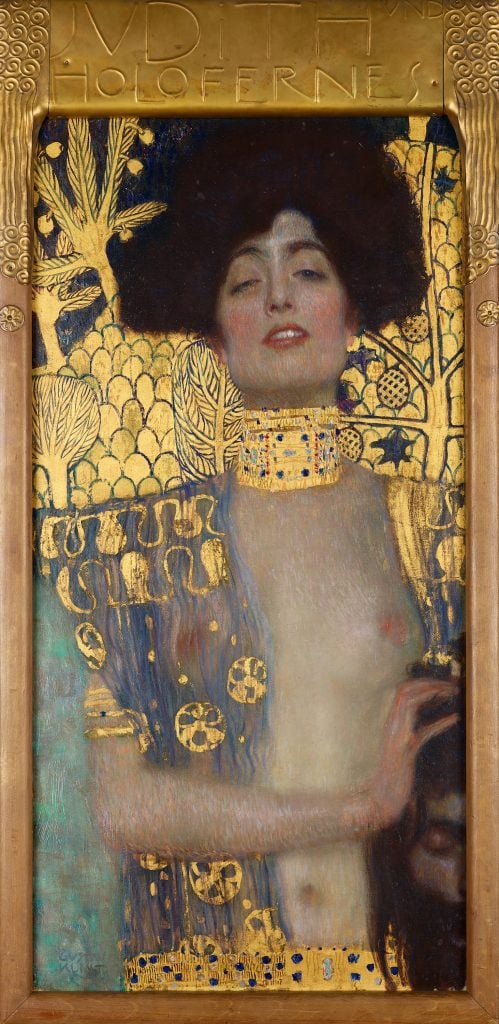
Gustav Klimt, Judith (1901). Found in the Collection of the Galerie Belvedere, Vienna. Photo by Fine Art Images/Heritage Images via Getty Images
His most famous painting, The Kiss (Lovers) (1907–1908), too, courted controversy with overt allusions to religious icons while exalting not God, but man and woman. Looking closely at the man and woman’s garments in The Kiss, one notices Klimt has used gold to create upright, rectilinear forms on the man’s robe, which offer a masculine counterpoint to the swirling, ovoid forms on the woman’s gown (Klimt was fascinated by microscopic biology, cells, and fertilization, which was being researched intensely by early 20th-century scientists).
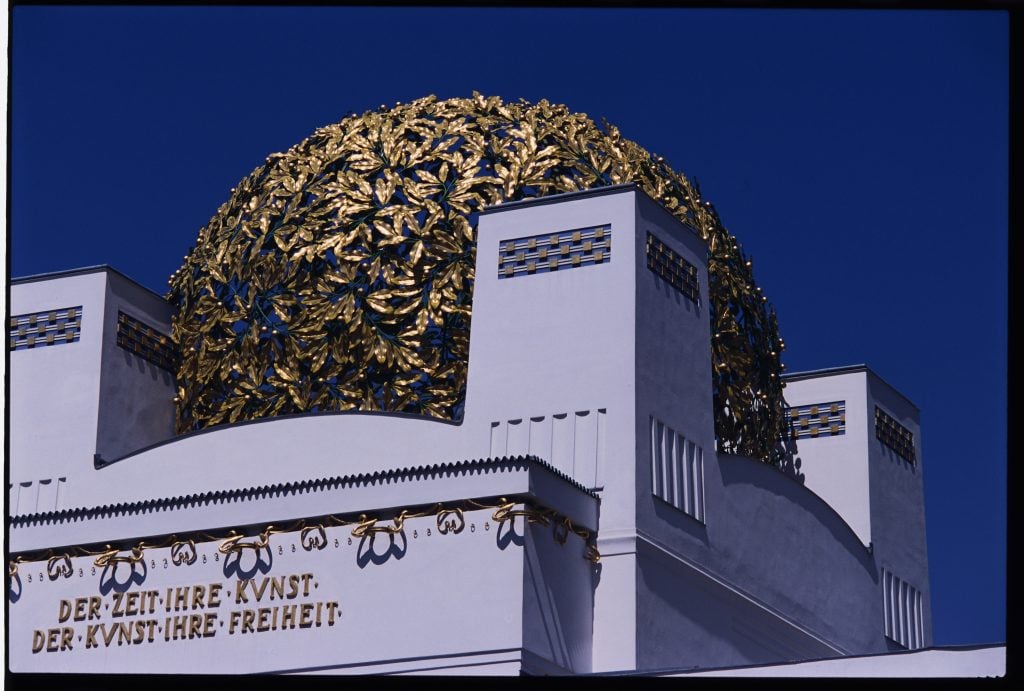
Dome of Secession Building, Vienna. Photo by Chris Hellier/Corbis via Getty Images.
Gold Celebrated the “Object-Ness” of Art
While Klimt might be the painter of the Vienna Secession most deeply associated with gold, he certainly was far from the only artist working with the medium. Leading Secession artists, Koloman Moser, a graphic designer and painter, and architect Josef Hoffmann established the Wiener Werkstätte in 1903. A productive association, Wiener Werkstätte brought together creatives across disciplines to create utilitarian objects from leather goods to jewelry. Gold and gilt objects and details were quite popular.
Gold featured prominently in the Secession Building in Vienna designed by Joseph Maria Olbrich, characterized by its unique gilded leaf dome (a few gilded cabbage leaves were nabbed under the dark of night in 2018, in fact). In his paintings, Klimt’s embrace of gold imparted an object-like quality to his paintings—the gold work at once compressing the picture plane while giving the canvas a sculptural, jewelry-like quality. In this way, Klimt’s embrace of gold put his works in conversation with the design and decorative artists of his time and reflected the very modern sensibilities of Vienna Secession artists.
“Secessions” is on view at Wien Museum until October 13, 2024





